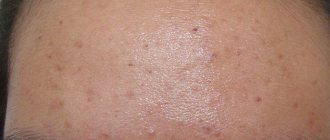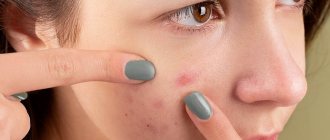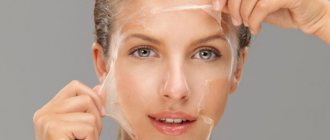What is post-acne
Acne can appear on the face and neck, in the interscapular area, on the back and in the upper chest. Acne or acne is the formation of inflammatory elements on the skin - compacted reddened tubercles (papules) and blackheads, purulent white heads with redness around them. If elements are injured, squeezed out or heal poorly, post-inflammatory, scarring, and pigmentary changes form on the skin - this is post-acne.
This is what post-acne looks like
Can acne spots go away on their own?
Post-acne pigmentation and stagnant spots do go away on their own, but for how long is another question.
If we talk about post-acne pigmentation, then its “lifespan” depends on the amount of pigment and how deep it is located, because the pigment leaves during the renewal process along with skin cells.
Erythema, in turn, goes away faster. But the longer and stronger the inflammation, the slower the stagnant spots will disappear.
This is actually why no one can say exactly how long it will take: it could be 3 weeks or several years (in the case of pigmentation).
Reasons for the appearance and areas of localization of post-acne
The skin is the largest organ in the human body, and it has a complex structure. In addition to the epithelial cells that form the continuous skin, there are also hair follicles, sweat and sebaceous glands. It is the glands that secrete sebum and form a protective hydrolipidic mantle on the surface of the epithelium that suffer during the development of acne.
To begin with, it is important to understand why acne occurs. When the sebaceous glands malfunction, the epithelium in the area of the ducts thickens, the lumen of the gland narrows and sebum cannot be regularly and fully released through the pores to the surface. Then the fatty secretion is retained inside the gland duct itself, which provokes inflammation with the participation of microbes that are constantly present on the surface of the skin, making up its microflora.
The process of acne formation goes through certain stages:
Initially, comedones are formed - an increase in the size of the sebaceous gland. Nodules form in the skin with an irritated opening of the sebaceous gland. As the process develops, black dots form in the center, and disturbances in the outflow of sebum, microbial activity, and the work of leukocytes during inflammation lead to the formation of purulent heads (pustules).
By themselves, these elements can leave behind scars and uneven skin, and if they are further injured, if you squeeze out blackheads or purulent heads, the inflammation only intensifies, and the purulent contents can spread to neighboring areas of the skin.
To prevent inflammation from spreading, to prevent damage to more and more areas of tissue, and to prevent pus from penetrating into neighboring areas, inflammatory changes form around the damage to the sebaceous gland.
Swelling occurs in the area of the pimple, collagen production is stimulated, scar changes are formed: connective tissue elements are formed, new capillaries grow, which gives redness, the work of pigment cells is stimulated - pigment spots are formed - persistent and with uneven edges.
Especially often, problems arise on the face, mainly in the forehead, on the nose and cheeks, on the chest, they also appear in the décolleté or on the back.
Redness disappears over time, pigmentation becomes less bright, scars can atrophy, forming dimples, or, conversely, become convex and rough.
Why Acne Scars Make Skin Uneven
There are several types of acne: superficial, medium and deep (boils). The most noticeable scars remain after acne-boils. They are easy to recognize: they look like a voluminous and painful redness under the skin that does not have a purulent head.
A deep boil is a signal that the inflammatory process takes place not in the papillary, but in the reticular layer of the dermis.
Very often, a scar is formed after squeezing out pimples, when suppuration spreads from the upper sections of the skin to the lower, mesh.
Inflammation and pus destroy the layers of skin around it. Imagine the soil being washed away by an underground stream - it will fail. Much the same thing happens to our skin.
Purulent inflammation “washes out” the voids. But nature abhors a vacuum - and our body launches a mechanism for the formation of replacement scar tissue. The scar does not fill, but in order to save money, it lines and “glues” the edges of the lacuna. This is how the first skin sagging appears.
At the formation stage, the scar is moist and voluminous. But over time it dries out and shrinks. This is the second reason for sinking. As a result, we have “crumpled” skin, inside of which there are deep post-acne scars. On the surface this manifests itself as irregularities and craters.
Types and stages of post-acne
Among the main signs of post-acne, hyperpigmentation is identified - these are areas of normally colored and darker skin, alternating with each other and forming an uneven tone.
In addition, the typical presence of stagnant red spots, enlarged skin pores, often filled with sebum, as well as pathological scars. In the area of blockage of the sebaceous glands, atheromas (sebaceous gland cysts filled with fatty secretions) or milia (whiteheads) are formed.
The main sign of post-acne is old cicatricial changes, scars after healed purulent acne. They can take three forms:
- depressed areas of skin, dimples (or atrophic scars);
- convex, lumpy areas, often with areas of erythema (hypertrophic);
- areas of dyschromia (the surface of the skin is spotty, with areas of increased pigmentation).
Sometimes the formation of keloid scars is mistakenly added to the classification. This is the wrong approach. People with a hereditary predisposition to the formation of rough and poorly healing scars that disfigure the appearance do not often suffer from acne, and therefore post-acne phenomena are rare for them.
The most common type of post-acne is the appearance of atrophic scars. According to the Jacob CI classification, they can take the form of rounded, chipped and square elements. This division helps doctors plan treatment and predict its results.
Round scars are the shallowest, and the prognosis for them is the most favorable. The square ones are somewhat deeper, but are also eliminated quite well. The biggest problem is the chipped forms of post-acne, they look like the Latin letter “V”, their bottom is located deep in the dermis.
Types of skin damage from acne
Photos "before" and "after"
Subcision is the most effective way to treat acne scars. The result “before” and “after” of one procedure. Surgeon: Vasiliev Maxim.
Correction of deep scars. Before and after photos of one session. Completed by: Vasiliev Maxim.
Laser resurfacing of post-acne scars. Performed by dermatocosmetologist Elena Vlasova.
Ways to get rid of post-acne
The intensity of post-acne is directly related to the severity of acne. Therefore, it is important to work not only to eliminate the consequences, but also to prevent the appearance of new elements on the skin. It is necessary to fight acne itself, eliminating its main causes. If pimples appear again and again, the prognosis for post-acne treatment is questionable; inflammation will give rise to new scars. Therefore, work with an experienced dermatologist-cosmetologist is required.
Most of the work on restoring, smoothing the skin and eliminating scars is carried out by a cosmetologist, but certain activities can also be performed at home. Moreover, only an integrated approach will give the most maximum results.
What can you do at home?
At home, you need to help the skin recover; it needs building elements and proper nutrition. To regenerate the skin and form its structure, it is necessary to supply vitamins and minerals, protein as a source of amino acids for the construction of collagen fibers and the synthesis of hyaluronic acid, which moisturizes and gives the skin tone and smoothness.
In addition, omega acids are important, which are involved in cell renewal and form cell membranes. It is important to adjust your diet, eliminate as much processed foods as possible, food chemicals (dyes, preservatives, E-additives) and give up bad habits.
To prevent new acne and improve tone, nourish the skin, heal inflammation and small scars, pharmaceutical products will help. You can use 1% salicylic alcohol or boric acid and wipe the skin with it twice a day. Levomekol ointment works quite well in treating acne, suppressing inflammation and eliminating scars. Many people use bodyaga powder, which is diluted in water to a paste and applied to the affected area. But before using all these remedies, it is important to first consult with your doctor to prevent side effects and complications.
Skin care is complemented by serums, care creams (day and night) selected by a cosmetologist, as well as homemade peelings with fruit acids. They delicately exfoliate the skin, remove dead cells, and cleanse its surface.
Folk remedies are often used, for example, infusions of St. John's wort and chamomile, which have an anti-inflammatory, soothing, cleansing effect. You can freeze them and wipe the skin with the resulting ice cubes, further increasing blood circulation and capillary tone.
You can also use masks with blue clay. The recipe for making a mask is very simple: three tablespoons of powder are diluted in water to a paste, applied to the problem area for 20 minutes and then thoroughly washed off with water.
What treatment methods are used in a cosmetology clinic?
Although homemade recipes help in the fight against post-acne, you should not think that only through them you can eliminate all problems. Home methods act on the very top layers of the skin and reduce only minor defects.
Modern cosmetic procedures will help get rid of deep scars, pigmentation and unevenness. But don't expect instant results.
Treatment methods are selected individually and comprehensively. The more severe the initial problem and the wider the affected area, the longer the treatment will be.
To achieve maximum smoothness of the skin and an even complexion or eliminate blemishes on the body, you need a whole series of procedures, supplemented by home care and carefully selected cosmetics. On average, the first noticeable results will be visible after 1-2 months with regular implementation of all necessary treatment measures.
If there is unevenness, decreased skin tone, pigmented or stagnant spots, peelings . There are a lot of treatment options: these can be mechanical peels (compositions with herbs, small dense particles) and chemical peels (with retinol, glycolic, resorcinol or other compounds).
With mechanical peeling, the effect of cleansing and exfoliation is achieved due to the mechanical scraping of the particles included in the composition of the upper layer of skin with outdated epithelial cells.
With chemical peeling, a similar effect is achieved through chemical cauterization of the upper layer of the epidermis, which leads to its subsequent rejection with peeling.
The cosmetologist selects peelings to suit your needs and strictly follows all the rules for their implementation in order to achieve maximum effect and avoid side effects. On average, the first results are visible after 5-6 procedures.
A more effective analogue of peeling is laser skin resurfacing . The doctor performs the procedure with a special laser unit with a strictly specified wavelength in order to influence the skin at the required depth without damaging neighboring tissues. The laser beam cauterizes the skin, the treated areas are actively exfoliated, which allows stimulating the regeneration of new tissues, more even and smooth.
Check out our patient's review of laser facial resurfacing:
Photothermolysis is a more advanced method of laser skin treatment. The rays do not act as a continuous field, but as individual points - creating a mesh on the treated area. This is a fairly effective, but less traumatic effect; the rehabilitation period after such procedures is reduced.
dermabrasion is used to combat skin imperfections . This is the use of aluminum oxide powder under pressure or a special rotating abrasive disc for mechanical grinding of the skin, removing the upper layers of the epidermis from it.
Filler injections can help eliminate atrophic scars and dimples and smooth out the skin . They are inserted under the defect area, create additional volume, and lift depressed skin. The effect lasts up to 6-10 months (depending on the drug), then the injections are repeated.
Mesotherapy with drugs that stimulate collagen synthesis and epidermal renewal gives good results A series of microinjections are made into the surface layers of the skin with the introduction of hyaluronic acid, antioxidants, and vitamin components. The cosmetologist selects a specific drug depending on the tasks and the severity of skin defects.
Another method is ozone therapy . This is a technique of introducing a special oxygen mixture into a problem area through a series of microinjections. The composition helps saturate tissues with oxygen, stimulates blood circulation or lymph drainage, and epithelial regeneration.
If no other methods have produced a significant effect, surgical removal of scars can be used. The affected scar tissue is excised within the boundaries of healthy skin. The rehabilitation process is long, and the intervention itself can also leave scars in the future.
Post-acne treatment at Dr. Gruzdev’s clinic:
Chemical peeling The clinic offers gentle superficial peels: almond and glycolic.
More details
Laser resurfacing Impact of a laser beam on problem areas of the surface layer of the dermis.
More details
Biorevitalization A non-surgical technique for facial rejuvenation using preparations based on hyaluronic acid.
More details
Mesotherapy An injection technique for introducing “cocktails” into the skin based on vitamins, microelements, and amino acids.
More details
How to Get Rid of Acne Spots with Physiotherapy
To increase the effectiveness of cosmetics, physiotherapy is used - in the case of post-acne spots, we recommend using phonophoresis or microcurrents for a more pronounced result.
Today we’ll talk about phonophoresis. With this procedure, the beneficial substances of the gel or cream are delivered to the deep layers of the skin thanks to the influence of ultrasound.
The transferred components accumulate in the form of a medicinal depot in the skin and subcutaneous fat, significantly increasing the effectiveness of the drug and the time of its action. This is why the effect of physiotherapy lasts longer than a course of skin applications.
To conduct a session, you need a medium - a gel or cream with active ingredients that need to nourish the epidermal cells and eliminate the deformed substrate. The cosmetic product is applied only to previously cleansed skin! Since air does not carry ultrasound, you should press the emitter head tightly against the gel/cream application at the site of the problem area.
Next, the required ultrasound frequency is set - the lower the number, the stronger the effect on the body. Thus, at a frequency of 800–1000 kHz, ultrasound penetrates 5–6 cm, and at 2400 kHz, 1–2 cm. In the case of acne spots, a greater depth is not needed to solve a problem not of a medical, but of a cosmetic nature, deeper than 2 cm not worth influencing.
One session of phonophoresis takes 10–15 minutes, depending on the specific case and the severity of pigmentation. To remove red spots from acne, you need to complete a course of 8–15 procedures at intervals of a day or two.
How to quickly lighten or disguise post-acne
It is important to understand that the fight against post-acne is a long-term process; it is necessary to gradually even out the skin, stimulate the regeneration process, normalize blood circulation and metabolic processes in the epidermis and dermis.
Primers, foundations and decorative cosmetics can hide skin defects, but they do not improve, but only worsen the situation, clog pores, prevent the skin from breathing and create a breeding ground for bacteria.
It is impossible to hide acne marks, eliminate scars and even out your complexion by eliminating pigmentation in one day or even a week.
Home peelings will only improve the situation a little, but for deeper effects (chemical peels, laser, mesotherapy) time is needed for rehabilitation (exfoliation, elimination of redness and skin irritation).
To eliminate pigmentation and whiten the skin, a series of procedures and properly selected cosmetic products for subsequent care are required. There are simply no miraculous and safe products that, when applied overnight, will eliminate all unevenness and imperfections.
Why facial scars after acne cannot be removed with laser
The advertisement claims that the laser removes scars from the skin without leaving a trace. In the case of receding acne scars, this is fundamentally wrong.
Laser peels and resurfacing are effective only against problems of the papillary dermis. Not a single doctor will undertake to smooth out the skin and grind away acne scars to the level of the mesh layer - this is a 100% guarantee of the appearance of new scars (we remember that the mesh layer is restored only by scarring).
Only subcutaneous microsurgical cutting of scars using the subcision method copes with scars of the mesh layer and smoothes the skin. Maxim Vasiliev’s method is based on subcision, which removes scars of any depth.
Subcision is a painstaking method of correcting atrophic post-acne scars.
Review
“In my youth I suffered greatly from acne, I waited a long time for it to disappear on its own. On the advice of a friend, I squeezed out the pimples - it only got worse. As a result, acne left scars and spots all over the body, even on the butt. What to do?
I turned to Platinental in hopes of laser resurfacing, but I was referred to Dr. Vasiliev Maxim. It turns out that acne scars cannot be solved with laser; for such cases, there is another method - subcision.
I am very pleased with the first results, the scars have already been removed from my face, my skin has become much smoother.”
How to prevent acne and post-acne
To prevent acne and the development of post-acne, you must follow the rules of face and body care. It is important to use cleansing and skin care products selected for your age and skin type, and use them only for their intended purpose and according to the instructions.
Do not squeeze blackheads or white pimples.
To speed up their healing, you can use special creams, serums or other targeted products. If acne does not go away or its number increases, a visit to a dermatologist is necessary.
To protect your skin from inflammation, try not to touch your face or rub it with your hands during the day; if you talk on the phone a lot, treat your gadget, as there are always a lot of bacteria on it that get on the skin.
Change your towels more often or ditch them in favor of disposable paper towels. Be sure to wash your face twice a day and take a shower. For washing, you need to choose mild cleansers. If you are prone to acne, you need a soft, delicate and well-cleansing cosmetic product. Regular soap or shower gel may be too harsh.
Forecast. Prevention
Colloidal scars are the most difficult to remove. Destructive methods are contraindicated here, that is, such defects cannot be excised, scraped, burned, or sanded. Otherwise, even more serious consequences may arise. Therefore, it is important not to bring the post-acne problem to such a state.
The main rule is to treat acne promptly and competently to prevent complications.
If after acne you have a stagnant spot
, your task is to prevent it from developing into a scar. To do this, you need to care for your skin in a special way.
- Do not subject the stain to rough physical, chemical, or mechanical stress
so as not to damage it. Minimum 3 months. - Don't stay in the sun for long periods of time.
- Moisturize your skin.
If you prefer pharmaceutical products, choose those that contain zinc hyaluronate (Curiosin, Regetsin, etc.).If you are one of the fans of natural cosmetics, pay attention to Beauty365 products.
To moisturize during the day and cleanse the skin, choose light and soft products - hydrolates (water distillates). It is best to stop at Beauty365 mint hydrolate and Beauty365 sage hydrolate - they “specialize” in oily and problematic skin.
Enhanced hydration and regeneration will be provided by Beauty365 squalane (sugar cane) and Beauty365 sasanqua camellia oil. Natural vegetable oils are the best way to soften rough skin. Camellia sasanqua will also help whiten stains.
- If you need to relieve inflammation, use a special remedy.
For example, ichthyol ointment (20%) is suitable. Within two weeks of use, the redness will subside.
If scars have already begun to form
, then you can lubricate them with ointment containing silicone dioxide or polysiloxane. It will create a film that will reduce fibroblast activity and collagen production.










